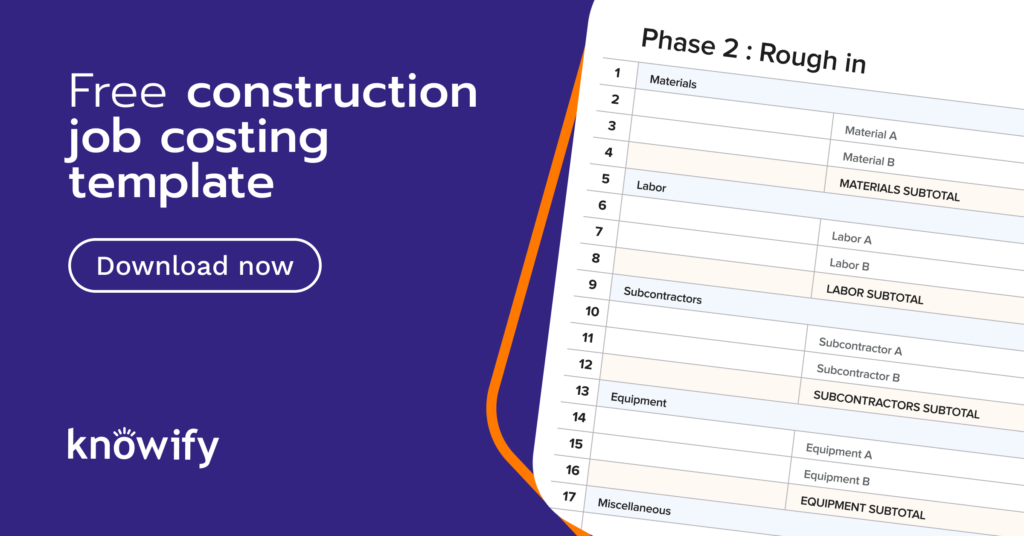For contractors, the road to success is riddled with obstacles. In the face of ever-changing material expenses and fierce competition, you must deftly maneuver through a multifaceted industry landscape to remain financially stable. However, there’s a powerful weapon at your disposal: job costing.
The importance of job costing cannot be understated. By monitoring and scrutinizing project expenditures, you can unlock valuable insights and make strategic choices that bolster your job level profitability.
In this article we’ll delve into the ways in which job costing can serve as a game-changing tool, equipping you with the necessary tools to conquer challenges and elevate your operations.
Problem 1: Higher than expected labor costs & crew productivity issues
Labor cost can vary quite a bit depending on your trade or industry. A service business may see 50% or more of the total cost go toward labor, especially when accounting for labor burden costs. If labor costs are impacting your profitability, any time you spend improving labor, whether through mentoring, training or improving productivity, will always be time well spent.
If job costing shows that you are systematically underestimating labor costs, that is a problem. Especially if you are operating with tight margins. Even a small overage in labor costs can affect your bottom line. On top of that, it’s a warning sign that your bidding process is inaccurate. To address this, you need to consider a few things.
First, evaluate your team’s productivity and work output. If your team is consistently hitting output goals and completing projects on time and under budget, you may need to raise your bid price or cut costs elsewhere to hit your profitability goals. This scenario, however, is largely dependent on your team’s ability to perform at a high rate of productivity consistently.
You can find ways to solve crew productivity issues by evaluating time cards. To do this start by examining how time was actually used on past jobs. Was there time spent waiting? Doing rework? Did the scope change? If you break down your job into phases, you’ll be able to see if your crew’s time was utilized correctly on each task.
For example, it could be that too many people were used on one phase and not enough was used on another. Use this information to better allocate your crew for tasks that you know will require extra hands or tasks that can be done with a limited crew.
The importance of job costing comes through in its ability to tell you how labor productivity is tracking against your estimated budget. Using phases will tell you what task is behind or ahead of schedule. If actual work hours are above your estimate, you should increase the number of hours budgeted for that phase for future projects. If the actual hours are lower than your estimate, you should decrease the number of hours on this phase for future projects.
This is why evaluating your team’s efficiency and productivity for each job is so meaningful. Never stop working on perfecting your craft, and never stop working to bring your team up to that standard. Ensure your team, down to the person, is hitting output goals and performing at a productive and sustainable level. Job costing will allow you to set and track these goals down to the person.

While employee performance is a key factor influencing labor, managers and owners are not off the hook. Leaders must ensure they provide every resource, tool, and opportunity their team needs to succeed. This means creating employee handbooks, providing bonus opportunities, and setting standard operating procedures.
Your team needs to know what is expected of them. Going even further, it’s recommended to provide comprehensive training programs for new and existing employees; and then review performance regularly. Take the time to mentor your team and ensure you put them in the best possible position to succeed.
As a manager or owner, you have the power to set the values of your business. Even more, you have the power to uphold those values and empower your team to develop and grow along with your business. Invest in your team, and the rewards will far outweigh the costs.
Problem 2: Estimating issues
To start, ensure you have a process for consistently estimating and pricing your jobs. Through job costing, you can see trends and patterns for similar jobs. It’s crucial that you price similar jobs consistently so that you can better evaluate performance, cost overruns, and inefficiencies.
An electrical contractor who often installs EV car chargers will need a consistent process for pricing those types of jobs. To make life even easier, using job costing software like Knowify, you can create templates for these kinds of recurring jobs and can tweak them as needed to ensure they are accurate and specific to the job.
In contrast, if your team is tackling a job they rarely do or have never done before, it’s important to take this into consideration and allow for variability in your numbers. Make note of this so you can reference it for any future jobs of this nature and accurately account for the uniqueness of the job.
To take things further, you should always track your bid-hit ratio. Only 6% of contractors take the time to track this number. Knowing your bid-hit ratio can be a game changer for making better choices for your business. Bid-hit ratio calculates the rate at which you successfully win jobs when bidding on projects.
For example, a plumbing contractor may have a bid-hit ratio of 5:1, meaning they successfully win one job for every five projects they bid on. You can use a bid-hit ratio as an indicator of how effective your bidding process is, helping you determine what jobs to go after. This number can also provide insights into what jobs give you a higher percentage of work.
Determining the right ratio for your business, like most metrics, will depend on the specifics of your industry. A contractor who completes a high volume of jobs per year and is constantly negotiating will likely have a lower ratio. In contrast, a contractor who obtains work in the public sector will likely have a higher ratio.
| General contractors Bid-Hit ratio | Subcontractors Bid-Hit ratio |
|---|---|
| Public Works: 10:1 Private Bid Work: 6:1 Negotiated Work: 4:1 | Public Works: 11:1 Private Bid Work: 6:1 Negotiated Work: 4:1 |
A 1:1 bid hit ratio is virtually impossible, so the next best ratio would be 2:1 right? Maybe not. Regardless of your industry, if you are tracking your bid-hit ratio and seeing it consistently coming in at 2:1, this likely means you are underpricing your work.
Complete as many jobs as possible to sustain a healthy cash flow, but stay within reason. Ensure you are maximizing the amount you charge on jobs while simultaneously providing the best possible quality of work. Just be careful not to overextend yourself or overpromise.
By consistently reviewing job costing data, you should be able to create templates that you can add or remove items from as needed for individual jobs/tasks. This gives you flexibility and speeds up the time it takes to estimate a job.
You’ll also be able to evaluate all past jobs and understand labor costs and which crews you should schedule for tasks to increase productivity. All added up, this information will enable you to create better estimates that are accurate and achievable.
Problem 3: Higher than expected material cost
If climbing material costs are putting a strain on your business, job costing can help. Start by focusing on a project/job that you take on consistently. If you’ve been job costing persistently, you can look at what you have been spending on past jobs and work to identify exactly why these costs came out the way they did.
Did you overspend or underspend on materials? If so, why? Did you account for things such as fluctuating market rates, leasing costs, or supply chain issues? Once you determine the ‘why,’ you can start thinking about setting a target spend amount. Answering these questions will help you adjust your markup as needed and give you the information you need to control costs.
If you feel you are consistently overspending on material costs, it’s likely due to one of two reasons:
1) You’re not accurately estimating material costs or,
2) There are flaws/inefficiencies in how you are using those materials. Determining how much of total spend should go towards material costs depends on your trade.
Will a professional painter need to cost out every individual piece of tape or ounce of spackle used? Most likely not. You can track all sundries if you want, but this can quickly convolute your line items. However, you should still work to be as granular as possible.
Every piece of cost data will help you make better decisions. Consider building out and using a price list. This can eliminate much of the pain and time needed for detailed material cost tracking. Be as granular as you are comfortable with, and remember that digital tools can do much detailed work for you.
With that said, if you’re not hitting profitability goals and consistently notice material costs increasing, take some time to evaluate the efficiency of your business practice. Consider if you could be doing more in regard to training your crew, coaching, and setting standard procedures for efficiency. Boosting efficiency can reduce costs on several fronts and offset high material costs.
Final thoughts
As an owner, you need to know where to direct your business for long-term success. You need to know the how and why of your business. The reality is that there are certain areas of every trade that are more or less competitive, and there are certain areas where you are better than the competition.
This is where the importance of job costing comes into play. It will identify these areas so you can lean into them and build your business pragmatically. The best part? Getting started with job costing is simple and inexpensive.
Using industry-specific software like Knowify will give you the tools you need for real-time insights into job performance and assist with budgeting for each job. It’s our mission to help you grow job-level profitability. Which is what job costing is all about.
Schedule a 30-minute demo with Knowify today. Seeing is believing, and we’ll show you a paperless, efficient, and robust digital future for your business.
